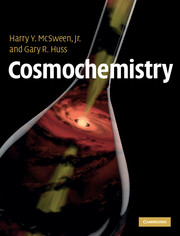Book contents
- Frontmatter
- Contents
- Preface
- 1 Introduction to cosmochemistry
- 2 Nuclides and elements: the building blocks of matter
- 3 Origin of the elements
- 4 Solar system and cosmic abundances: elements and isotopes
- 5 Presolar grains: a record of stellar nucleosynthesis and processes in interstellar space
- 6 Meteorites: a record of nebular and planetary processes
- 7 Cosmochemical and geochemical fractionations
- 8 Radioisotopes as chronometers
- 9 Chronology of the solar system from radioactive isotopes
- 10 The most volatile elements and compounds: organic matter, noble gases, and ices
- 11 Chemistry of anhydrous planetesimals
- 12 Chemistry of comets and other ice-bearing planetesimals
- 13 Geochemical exploration of planets: Moon and Mars as case studies
- 14 Cosmochemical models for the formation of the solar system
- Appendix: Some analytical techniques commonly used in cosmochemistry
- Index
- References
4 - Solar system and cosmic abundances: elements and isotopes
Published online by Cambridge University Press: 05 June 2012
- Frontmatter
- Contents
- Preface
- 1 Introduction to cosmochemistry
- 2 Nuclides and elements: the building blocks of matter
- 3 Origin of the elements
- 4 Solar system and cosmic abundances: elements and isotopes
- 5 Presolar grains: a record of stellar nucleosynthesis and processes in interstellar space
- 6 Meteorites: a record of nebular and planetary processes
- 7 Cosmochemical and geochemical fractionations
- 8 Radioisotopes as chronometers
- 9 Chronology of the solar system from radioactive isotopes
- 10 The most volatile elements and compounds: organic matter, noble gases, and ices
- 11 Chemistry of anhydrous planetesimals
- 12 Chemistry of comets and other ice-bearing planetesimals
- 13 Geochemical exploration of planets: Moon and Mars as case studies
- 14 Cosmochemical models for the formation of the solar system
- Appendix: Some analytical techniques commonly used in cosmochemistry
- Index
- References
Summary
Overview
In this chapter, we discuss the abundances of the elements and isotopes in the solar system. First, we look at the techniques used to determine solar system abundances, including spectroscopy of the stellar photosphere, measurements of solar wind, and analyses of chondritic meteorites. The solar system abundances of the elements and isotopes are then presented. These abundances are then compared to the abundances in the solar neighborhood of the galaxy and elsewhere. Finally, we introduce how solar system abundances provide a basis for much of what we do in cosmochemistry.
Chemistry on a grand scale
The bulk chemical composition of the solar system is an important cornerstone of our ideas about how the Sun formed, and how the various planets, asteroids, meteorites, and comets came to be as we see them today. In older literature, you will typically see the term “cosmic abundances.” In more recent literature, this term is being replaced by “solar system abundances.” This shift reflects an evolution of our understanding of the composition of the solar system and how it relates to that of the surrounding neighborhood and the galaxy as a whole. The terms have been interchangeable for most of the past century, and for most purposes in cosmochemistry, they still are. However, as we continue to learn about how the solar system came to be, it will become important to be specific about which composition we want to discuss.
- Type
- Chapter
- Information
- Cosmochemistry , pp. 85 - 119Publisher: Cambridge University PressPrint publication year: 2010
References
- 1
- Cited by



